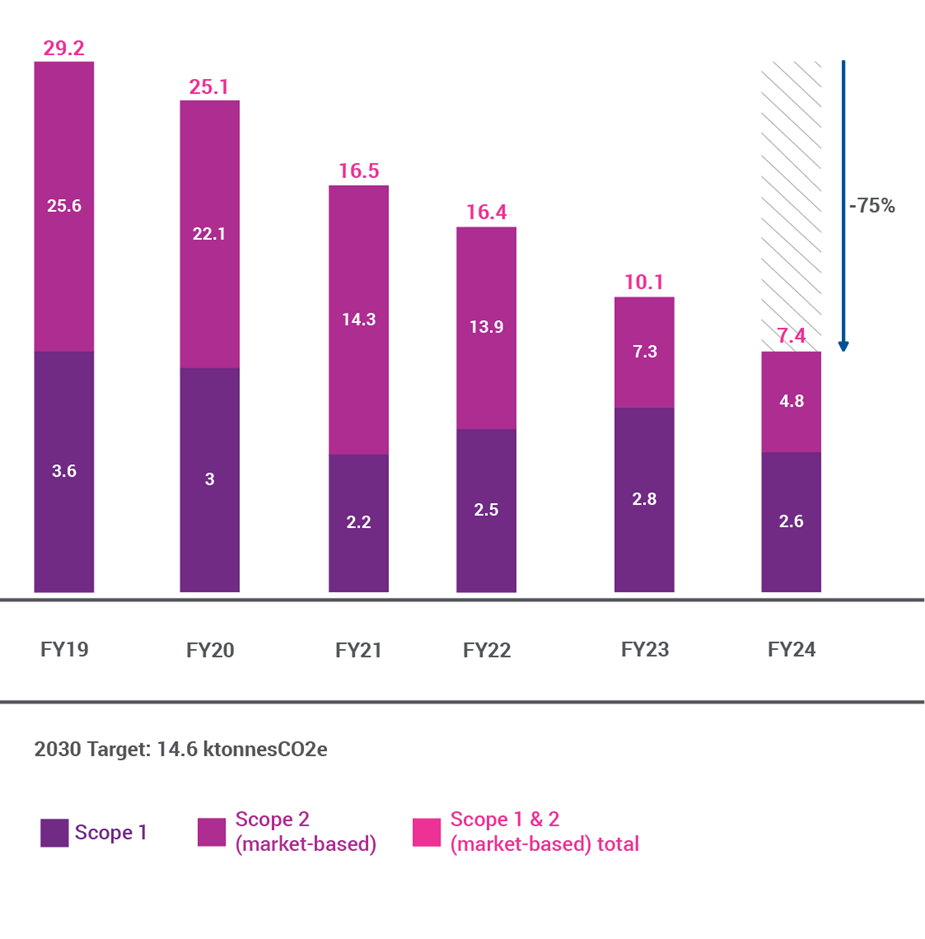At Experian we’re committed to helping tackle climate change and reducing our impact on the environment.
As an information services business, our most material environmental impact is the carbon footprint of our operations and value chain. To reduce this impact, we have science-based targets and, decarbonisation roadmaps across our regions focusing on areas such as renewable energy procurement, energy efficiency, single-use plastics and engaging with our supply chain.
Head to our ESG reporting hub to find our latest performance data, our TCFD report and CDP climate change disclosure.

Our climate goals
Our science-based targets provide direction for the level of reduction and pace required to cut emissions from our operations and value chain, as we continue our journey towards Net Zero. Our targets are:
To reduce our scope 1 and 2 absolute emissions by 50% by 2030 (from 2019). This target has been validated by the Science Based Target initiative (SBTi) as in line with a 1.5 degree scenario.
Our new scope 3 target - Suppliers covering 78% of Experian’s spend to have science-based targets by 2029. We will be submitting to the SBTi for validation in line with a well below 2 degrees scenario.
We also have a commitment to gradually carbon offset 100% of our scope 1 and 2 emissions by 2025.

Progress against our goals
This year we reduced our Scope 1 and 2 market-based emissions by a further 27%. Since 2019 we have reduced our total Scope 1 and 2 emissions by 75%, which means we are currently outperforming and well on track to meet our science-based target.
How we are driving action on climate change and protecting the environment
1. Renewable energy
We continue to explore opportunities for self-generation and abate emissions through the procurement of renewable engergy.
- In FY24 75% of the total electricity used in our operations was renewable (backed by renewable energy credits)
- Our data centres in North America, the UK and Ireland, have been running on 100% backed renewable energy since 2022
- In FY22 we installed our first solar PV array in our offices in Sao Carlos (Brazil)
2. Supply chain emissions and supplier engagement
Scope 3 greenhouse gas emissions account for the majority (97%) of our total carbon footprint making our supply chain an integral part of our sustainability strategy. As part of our ambition to reduce emissions across our value chain, we want to work with suppliers that share our commitment to sustainability and will collaborate with us to drive climate action.
We’ve made a commitment that 78% of Experian’s suppliers by spend are to have their own science-based target by 2029.
To achieve this:
- We'll include a set of binding climate related contract provisions into our supplier agreement.
- We continue to capture supplier emissions data and information through the supplier engagement programme at CDP (Carbon Disclosure Project).
- We already integrate climate considerations into supplier review meetings. In FY24, we held meetings with our top suppliers to understand where they are in their sustainability journey and discuss shared goals. We will continue this journey as part of our supplier engagement target.
3. Foundation of our Net Zero ambition and Net Zero Transition Plan
We continue to develop our Net Zero Transition Plan in line with the UK’s Transition Plan Task Force Disclosure Framework. This year we are pleased to share an overview of our approach - a set of goals, actions and accountability mechanisms to align our activities with the grounding principles of the Framework and shape the high-level structure of our transition plan.
4. Carbon offsetting
Once we have achieved our science-based target and reduced our value chain emissions as far as possible, we will invest in high-quality carbon offsetting projects to offset the remaining Scope 1, 2 and 3 emissions.
We offset 80% of our FY24 Scope 1 and Scope 2 emissions by investing in Verified Carbon Standard Projects in Malaysia and Colombia.
5. Single use plastics
We set out an internal ambition and roadmap for phasing out as much as possible of this avoidable single-use items in the next three years.
In FY24 we started targeting high impact single-use plastic types, for instance plastic stirrers, straws, cutlery bottled drinks and (what constitutes our highest volume) – plastic lined coffee cups.
Campaigns we ran across our regions resulted in a 33% reduction across our footprint since last year.
6. Our environmental impacts
- In addition to our focus on climate, we strive to understand and address other potential environmental risks and impacts from our business, including biodiversity and water use
- We are collecting data on water consumption to monitor trends and identify opportunities to reduce usage
- And we have used the Taskforce on Nature-related Financial Disclosures’ LEAP approach as a guiding framework, to map our operations against indicators of water stress risk and fragille ecosystems areas
- For more information see our ESG Performance Data
2024 Annual Report
Read the Sustainable Business section of our annual report for an update on Environmental performance.
TCFD
Our TCFD index shows how we’re reporting in line with the Task Force on Climate-Related Financial Disclosure.
Environmental Policy
Our Environmental Policy outlines our commitment to continually improving our environmental performance.